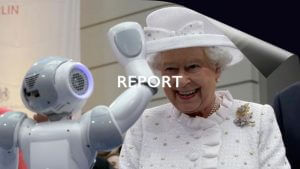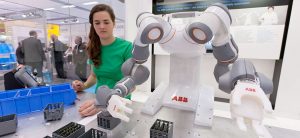UK automation strategy: the right idea, or economic suicide?
Chris Middleton warns that the UK’s moderate approach to robotics, AI, and automation may be economic suicide as we prepare to leave the EU.
 Another day, another apocalyptic news story about robots stealing human jobs. This time, the headlines shouted that over four million UK private sector jobs were going to be seized by machines: 15 per cent of the total workforce. Unusually, however, the story was sourced from YouGov statistics quoted in an in-depth report, The Age of Automation, published by the RSA.
Another day, another apocalyptic news story about robots stealing human jobs. This time, the headlines shouted that over four million UK private sector jobs were going to be seized by machines: 15 per cent of the total workforce. Unusually, however, the story was sourced from YouGov statistics quoted in an in-depth report, The Age of Automation, published by the RSA.
The 83-page document reveals the headlines to be sensationalist and inaccurate, which does little to help organisations locate the signal in the constant noise about a machine apocalypse. What the statistics actually say is that a clear majority – 60 per cent of the UK business and IT leaders questioned by YouGov – believe that the impact of AI and automation will be minimal to low. Twenty-two per cent see “zero potential” for automation in their businesses, while 38 per cent say that between one and 15 per cent of jobs may be automated. That’s a completely different story.
But what of the other 40 per cent of decision-makers? Twenty-seven per cent of respondents believe that 16-30 per cent of jobs may be automated over the next decade, while just 13 per cent believe that the technologies’ impact could be higher, with over 30 per cent of jobs being taken by the machines.
The YouGov findings stand in marked contrast to other UK studies, which have suggested that between 35 and 47 per cent of all jobs will be automated. The higher of those two estimates was made by Dr Anders Sandberg of Oxford University’s Future of Humanity Institute. Speaking at the Japan/UK Robotics and AI Seminar in February 2016, Sandberg said, “If you can describe your job, then it can – and will – be automated”. What sets the RSA report apart from the usual tabloid fodder is its suggestion that this is not the case:
“Our first conclusion is that AI and robotics are more likely to alter jobs than to eliminate them. Despite impressive advances in machine capability, many tasks remain outside of their scope, particularly those demanding manual dexterity and deeper forms of creativity and communication.
“Moreover, automation tends to be task-based rather than job-based, allowing workers to pivot into new roles should machines encroach on their turf. No single device can wholly substitute for retail assistants, care workers, hotel receptionists, or building labourers.”
That’s true, and as my report on automation vs skills reveals, robots are creating new skilled opportunities, as well as stripping away low-skilled, routine tasks. This makes skills and rising economic disparity the key societal issues.
But the RSA ignores two things in reaching its conclusion: first, robots are just as likely to be software as they are hardware – such as the chatbots that could replace up to one million UK call centre workers; and second, softbots tend to remove the first rung of the ladder towards professional careers.
Even so, uptake may be slower than the doom merchants predict. The report goes on to quote a Cisco and Capita survey of IT leaders, which found that while 50 per cent view AI as relevant to their organisation, just eight per cent are currently putting it to use. In the case of robotics, the figures are 39 percent and 10 per cent, respectively.
Yet despite the hype cycle we find ourselves in, these technologies are on an upward swing and create strategic challenges for every organisation, even if their uptake may not be as rapid as some predict.
Bumps in the road
So what are the barriers to faster adoption? The RSA identifies four: cost and business models; consumer preferences; regulatory concerns; and organisational integration. For example, the report discusses the healthcare market and other sectors in which specialist robots are expensive, rudimentary, and on a fast track to obsolescence – while incurring day-to-day maintenance fees.
This suggests that robots are like cars: depreciating assets, unlike humans who can constantly acquire new skills or set out to change their lives and employment opportunities – assuming that such opportunities exist where they live.
But metaphors are dangerous, as Milan Kundera once observed. It’s wise to remember that the car itself will change over the next few years: into an app-summoned, rentable service provider that can update itself overnight with data about how every other car in the world has been used. This ability to gather and crunch vast amounts of data is what sets the robots apart from human beings. Components might age – and can be replaced – but their intelligence can only increase.
Despite this, the report pursues the ‘depreciating asset’ angle: “Why invest in a RIBA robot if there are rumours of a more sophisticated caring robot just around the corner? And why plough money into a fraud detection algorithm with 95 per cent accuracy if there are expectations one will soon emerge with 99 per cent accuracy?”
Fair point, but that can be said of any technology, from cars, laptops, and smartphones to enterprise applications, and it doesn’t prevent organisations from buying them.
The critical question is why they buy them: strategically and sustainably to satisfy a real business or societal need? Or tactically in an unsustainable arms race towards lower and lower costs? This is the area that high-level studies ought to focus on.
Of course, the risks the RSA identifies can also be mitigated in the cloud with software as a service (SaaS) agreements, in the case of AI or software that automates back- and front-office tasks. This on-demand, plug-and-play model is emerging in hardware robotics, too, with Saviotic’s concierge robots and Starship Technologies’ delivery droids now available on rental, rather than purchase, schemes.
The phone droid

That said, the thrust of industrial robotics, for example, is towards smaller, faster, customisable platforms that are driven by sector-specific apps. This obviates the need to manufacture the kind of depreciating, single-task machines that the RSA focuses on.
In other words, think of the next generation of robots as being like scaled-up smartphones, which can carry out a range of complex manual tasks. The apps are the key; the rest is just speed, processing power, and dexterity.
Either way, organisations must reflect on their wider business strategy before buying in to these technologies, says the report. Decision-makers should weigh up the cost of a new technology versus the savings that could be made via traditional staffing or efficiency improvements.
“For organisations employing well-paid and highly skilled staff, there may be an obvious case for buying in machine alternatives (one reason why the financial industry is bracing itself for significant disruption). However, for organisations operating in low-skilled and low-paid sectors, including care homes, restaurants, bars, and some factories, it will continue to be cheaper to employ people.”
Again, this may be true – if one ignores the implication that skilled, highly paid humans are somehow a problem – but the RSA is behind the curve. The financial services industry isn’t ‘bracing itself’ for disruption, it’s already in the vanguard of the technologies’ adoption worldwide. The banking sector has long been little more than an automated compliance programme.
Ultimately, the RSA’s message is – correctly – that no technology is predestined to impact on society in the way that the doom-mongers predict: “As a society we have a choice in how to apply AI and robotics and manage their effects. […] These choices, however, are only relevant so long as the technology is being deployed. Indeed, just because a machine can do something, does not mean that it will be bought, integrated, and licensed to do so.”
That’s true, and we must do our utmost to steer these technologies towards sustainable development goals (SDGs) and societal benefits for all.
So how is the UK doing?
The UK conundrum
The UK has some of the world’s leading experts in robotics, automation, and AI. But one finding stands out from the RSA report, and it should sound a note of caution about all of the others: the UK must do better when it comes to supporting these technologies, or lose its chance of being a major player in the biggest new market this century. The report says: “Herein lies the rub for the UK: while as a society we have been quick to lament the rise of AI and robotics, as an economy we have been slow to adopt these technologies.”
The RSA reveals the extent of the problem in one sector alone. Far from capitalising on industrial robots’ ability to make manufacturing smarter and more efficient, robot sales to the UK actually fell in 2014-15, with the UK purchasing far fewer than the US, Germany, France, Spain, and Italy.
The report adds, “In 2015, the UK had just 10 robot units for every million hours worked, compared with 131 in the US, 167 in Japan, and 133 in Germany. While this may reflect our different sectoral make-up, UK businesses and public services as a whole suffer from stubbornly low rates of investment.
“ONS data shows spending on gross fixed capital formation – a measure of investment that includes plant and machinery, software and new dwellings – has barely grown in real terms over the last decade. Going further back, data from the World Bank shows the proportion of UK GDP accounted for by gross fixed capital formation has fallen by seven percentage points since 1990.”
These are alarming findings when set alongside the Global Innovation Index’s recent criticism of the UK’s poor investment levels in education and the national infrastructure [see my separate report on skills for more on this]. And that’s not all: according to Parliament’s Science and Technology Select Committee, up to 80 per cent of UK funding for RAS comes from the EU. Post-Brexit, that sustained level of funding must be in doubt.
This leaves the UK in a fascinating quandary: is Britain’s moderate, ‘steady as she goes’ approach the ideal model in a world that is automating too fast? Or is the country on a fast track to economic irrelevance, investing too little, too slowly, and too conservatively in a transformative technology, and nowhere near enough in educating its people?
Compare today’s YouGov predictions of a minimal impact of AI/robotics with many UK business leaders’ dismissal of the internet, ecommerce, or mobile phones in the mid-90s. Now imagine what the UK could have achieved had it properly invested in digital transformation on day one, or built Tech City in 1995, or backed Tim Berners-Lee with a billion pounds instead of a knighthood, or rolled out a nationwide fibre network when it had the chance.
It’s heartbreaking to consider what might have been. But then again, not even the US got everything right. Take this comment from a 1995 edition of Newsweek: “The truth is no online database will replace your daily newspaper, no CD-ROM can take the place of a competent teacher, and no computer network will change the way government works.”
That’s hindsight for you.
• A version of this article was first published on diginomica.
• AI and automation: the real political cost (Chris Middleton, diginomica)
• Did Jeremy Corbyn really call for a robot tax? (Chris Middleton, diginomica).
• UK’s claim to lead in robotics untrue, say auditors (Stuart Lauchlan, diginomica).
• For more articles on robotics, AI, and automation, go to the homepage and the Robotics Expert page.
![]() Enquiries
Enquiries
07986 009109
chris@chrismiddleton.company
© Chris Middleton 2017.
